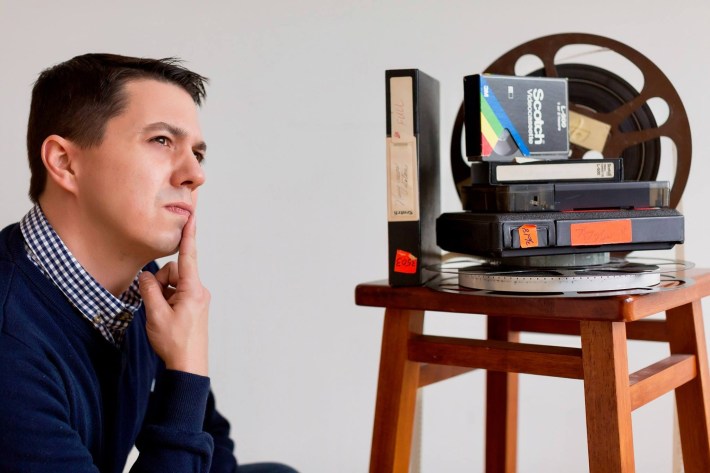Like many Gen X kids, Tom Oszman watched a lot of TV while growing up in the 1980s. Unlike most of those kids, his family had a commercial-grade VCR rig inside their Maplewood, Minnesota, home. Oszman got hooked on tapes early.
“Before DVD box sets were a thing, I was recording everything,” he says, describing himself as a “news junkie” from a young age. “I wore out the first family VCR, which cost like $1,000 at the time; other kids were playing with Fisher Price, I was pushing VCR buttons.”
After graduating from the University of St. Thomas and DePaul University, Oszman, who now works locally in the corporate world, dabbled in journalism, photography, and video production. He was an early YouTube adopter, which is where his lifelong love of tapes and TV news came back into play. In 2008, three years after the now-ubiquitous video platform launched, an amused Pioneer Press profile noted that Oszman had already uploaded "more than 50 clips on the video-sharing Web site" as TC Media Now, which would become a registered nonprofit by 2012. Today that number is pushing 3,000 videos, with new clips from the ‘60s through the '00s arriving weekly.
Over the years TC Media Now has acquired thousands of tapes—from garage sales, from viewers, from TV stations—and Oszman has stockpiled video production gear from schools and hospitals that no longer had room for the dated tech. “I put a lot of hours on VCRs each week,” he notes. Fans of his work include local TV news royalty like Don Shelby, Pat Miles, and Paul Douglas.

"People think TV news organizations have massive archives, and they do, but those archives are mostly of the taped material that aired," says Jason DeRusha, a longtime WCCO-TV anchor who pivoted to 'CCO Radio two years ago. "There are hundreds of thousands of hours of live shows that aren't saved anywhere. Tom's absolutely bizarre and nerdy obsession has been a tremendous service. Not only are these clips an amazing time capsule, they also are a real look at the first draft of history. Some of his clips are of major historical moments, but others show an ordinary day—complete with the vintage commercials, vintage TV news opens, and vintage fashion. I love it!"
Because tapes and reels are expensive and bulky to store and digitize, TV news stations don’t boast the extensive online archives you’ll find at places like the Star Tribune and the Pioneer Press. Even if properly stored—and that's a mighty big if—old tape decays as it ages, potentially erasing Minnesota history in the process.
“Someone has to do it, because I don't think anyone else is,” says Oszman, whose Maplewood home studio is bursting with around 5,000 tapes and stacks of vintage production gear. “It’s our history, and I think we’d regret it if it was just thrown away.”
While he acknowledges that his work “just scratches the surface,” he views it as filling an important gap in Twin Cities media history. Oszman says TC Media Now doesn’t turn down donations of tape, equipment, or funds. It’s getting harder and harder to find VCR repair pros, he reports, so if you’re a skilled tape machine tinkerer, hit him up.
“It still brings me joy but, ultimately, it’s about preserving the past,” he says. “You can take high intellectual content from the site, or you can enjoy the high shoulder pads, hairspray, and commercials—and I like it that way.”
Below, you’ll find the 10 TC Media Now clips that Oszman feels best represent the project, taking viewers from a rapturous Metrodome to battlefields in Vietnam to a certain fall snowstorm of the early ‘90s.
10. Dave Moore Leading the Nightly Newscast for 'CCO in '69
How many suited newsmen can you cram into one desk?
In the late '60s WCCO arrived at the answer you see above: four.
Dave Moore, Skip Loescher, Bud Kraehling, and Hal Scott conducted that evening's newscast shoulder-to-shoulder, with top stories including LBJ ramping up the Vietnam War, local narcotics raids, and indoor golfing in Bloomington. There's a delightful Old Dutch ad hard-selling three fun, versatile pretzel shapes; the charming weather report uses cardboard paper and pointing wands instead of green screen.
“Four men who look like accountants!” Oszman says with a laugh. “They look like they were working until the moment the cameras turned on.”
While the presentation might seem crude by today's glossy standards, WCCO-TV (formerly WTCN-TV) had been up and running for two decades at that point.
"I'm finally thinking about laying out some dough for the privilege of having a TV set around the house," the Minneapolis Morning Tribune's Will Jones wrote in a 1949 story about WTCN-TV and KSTP-TV launching weeklong programming in the Twin Cities. "Football, of course, is a good enough reason in the fall. But even aside from sports, TV programming here looks bright."
9: Do You Remember the Halloween Blizzard?
Talk about a story for which Twin Citians have a bottomless appetite. Local news outlets don't even have the restraint to hold off for nice, round anniversary numbers; the demand for annual retrospectives on the Halloween blizzard of '91 is too high.
KSTP's Val Holley-Dennis, seen above rocking extremely decade-appropriate shoulder pads, offered a prescient observation during his station's day-after recap of the historic weather event: "Certainly the worst I've ever seen. We're calling this the Halloween snowstorm of '91, though it's not the first, we think years from now we'll probably be saying, 'Remember all that snow we got on Halloween?'"
The TC Media Now compilation above features reports from KSTP, WCCO, and KARE 11, all of whom lean on three weathermen of prominent Twin Cities renown: Dave Dahl, who retired from 5 Eyewitness News after 43 years in 2020; Ken Barlow, who joined KARE in 1991 before returning to the market in 2011 with KSTP; and Mike Fairbourne, a 'CCO fixture from 1979 through 2011.
"It was a major, choking blizzard on a Thursday, on Halloween. Friday, everyone had off of school and work—the city shut down for a whole weekend,” Oszman says. “It was so unexpected in October. Too many ironic coincidences happened in one weekend… this clip comes up all the time.”
8: A Timeless Yet Distant KSTP Newscast from 1968
This nightly news report from KSTP begins with a blast-from-past sponsorship model, in which Northern States Power trots out its cartoon mascots to usher in the broadcast; they can't compete with the more famous/electric Reddy Kilowatt, but they stick around on John MacDougall's anchor desk.
"It's the oldest full Channel 5 newscast I've been able to find," Oszman says. "You have a cigarette commercial, everything is sponsored by something, it's just a snapshot of what everyone was watching in 1968. It's simple, it's complete."
The lead stories of the day would feel familiar across the decades: the tragic death of a Minneapolis child, a report on rising metro crime, Twin City Lines (a Metro Transit predecessor) hiking bus fares. MacDougall seems to have the most fun with a breezy report on a textbook cover that may include covert LSD messaging.
On the ad side, NSP gets a long spot devoted to the "FLAMELESS" kitchen of the future, a far cry from the gas stove culture war flashpoints we recently endured.
7: Toys, Cereal, the Gen X Nostalgia Overload
Oszman bills this compilation of retro toy and cereal ads as "Generation X sugar for the mind." He's not kidding. There are full websites and countless YouTube channels dedicated to long streams of throwback ads, those 30-second blips of copy, music, and colors that burrow into your brain's nostalgia centers like bugs.
"It's not just afternoon cartoon shows like He-Man, Scooby Doo, and Woody Woodpecker," Oszman says. "It's also the commercials that are loaded with toy and cereal commercials. It's sugar for the mind, it just makes you happy if you're of a certain age."
In our age of digital mind rot, the spots for Star Wars and Care Bear toys from Kenner Products summon a bygone era of kid creativity, even if designing in Minecraft (or whatever) exercises those same muscles. (The kid voicing C-3PO shows a nuanced, deep understanding of the robot's motivations and personality.)
The very fun ads for General Mills' cold breakfast cereal products, now considered a junk food by many, suggest an over-emphasis on lesser Pac-Man characters (Pac-Man Cereal) and the nutritional properties of marshmallows (Lucky Charms). The very notion of breakfast cereal might be considered nostalgic, as the former a.m. staple continues its decades-long market share decline.
6: Does TV Turn Your Brain to Mush? $500 to Find Out.
Click here to watch.
In an ambitious 1979 stunt, TV newsman Dave Moore—perhaps Minnesota's consummate TV newsman—orchestrated a study where WCCO offered $500 to five families, provided they could go without TV for a full month. Cue the Homer meme!
"I equate that to taking your phone away for a month, could you do that?" Oszman says. "In that documentary, which came from the St. Thomas library, I think two of the families made it the full month, and they talk about how they had to cope with each other and talk during dinner."
The question, more or less: How mentally corrosive is watching TV? We can't speak to the scientific rigor applied by Moore and his crew, but the project is undeniably intriguing and its very premise appearing via the medium of television is a hoot.
“It’s no accident that Moore appears so many times on this list,” Oszman says. “You can’t escape Dave Moore, and you shouldn’t—he was beloved and legendary for a reason, over 35 years at Channel 4. Walter Cronkite might’ve been the national personality with the most trust, but Dave was our local version of that.”
5: Moore Goes Long on Cults
As much as things change, certain threads of curiosity reliably entice viewers, readers, and consumers. Cults have to rank right at the top. Privy to that was—once again—Dave Moore. Moore's two-hour (!) documentary features former cult members, the "deprogrammers" who intervened on their behalf, and harrowing stories galore about life inside new religious movements and cults.
“I actually watched that tape in school,” Oszman says. “I mean, Hollywood or New York couldn’t put together a better production on the world of cults in the ‘70s.”
Local leaders from the Unification Church, the Church of Scientology, and the Samanta Roy Institute of Science and Technology were even extended rebuttable time by 'CCO. It's worth clicking for the jarringly psychedelic, brain-grabbing intro graphics and music alone, plus the vibe shift to the giddy, corntastic Post Toasties cereal ad that follows.
4: Twins Win!
Click here to watch
There's so much to like throughout this 73-minute special presentation that followed the Twins's Game 7 World Series win over the St. Louis Cardinals.
"This came from my personal tape collection; everyone taped this game, thinking it'd never happen again," Oszman says, adding that he shows it to nieces and nephews, all of them snakebitten Minnesota sports fans without non-Lynx championships in their lifetimes. "Today, you watch things over and over again on Twitter and YouTube, but that didn't exist then. The celebration is just so peaceful and joyful, it's a great snapshot in time before the digital age."
Our personal favorite moment might just be the sweet Rainbow Foods manager, Joyce Schoen, who details her staff's successful effort to lobby ownership to play the game live over the supermarket's PA system.
"What about the people who don't care about baseball?" our on-the-town reporter asks a driver outside of SuperAmerica. "They ain't nobody, heh heh heh!" he responds from behind the wheel. The swelling crowd shots of partiers outside the Metrodome, the jubilant player interviews... we have to get back to this place, emotionally, as a city!
3: 'CCO Filming CBS Filming The Mary Tyler Moore Show
Where else are you gonna see long-lost, behind-the-scenes footage of Mary Tyler Moore feeding Minneapolis ducks and grocery shopping at Red Owl?
"I can't say how I acquired this one," Oszman says slyly, noting that the clip emerged from a hulking trove of B-roll tapes. "It's a local production company, Channel 4, filming Mary Tyler Moore's production company. There's Red Owl, Burger King, Nicollet Mall... you don't see that sort of casual, fly-on-the-wall Mary Tyler Moore footage."
2: WCCO's Feature-Length, On-the-Ground Vietnam War Doc
As industry-wide bloodletting leads to increasingly vacuous TV news segments stuffed with inane banter, social media hot takes, and lifted viral clips, it's hard to imagine an era in which stations invested heavily into challenging, expensive feats of journalistic filmmaking. But that's exactly what WCCO did in 1969 with "Grunt's Little War," a 27-minute documentary from Al Austin that cataloged life on the ground for grunt-level Minnesota combat soldiers in Vietnam.
"He's about 21 years old. He was drafted, or he enlisted for one term. His war is a small patch of jungle spattered with three of his friends. He has killed a man," Austin says while introducing the four soldiers he embedded himself among, setting the unflinching tone of the doc.
Hopelessness and confusion ring loudly throughout; prisoner-of-the-moment misanalysis can dominate this type of reporting, but Austin skews toward longview context—as least as it applies to the American soldier.
"He sometimes thinks we are winning, but he can't explain what we will have won," his narration concludes. "He is lonely and he is angry."
With over 1 million views, “Grunt’s Little War” is the most-watched clip on TC Media Now’s YouTube channel.
"I don't even know if Channel 4 even has a copy today,” Oszman says. “Back then, they had the budget and the crew of a full documentary filmmaking company—just an outstanding reputation."
1: KARE's Groundbreaking Tornado Footage from 1986
As moviegoers await this summer's big blockbuster sequel, Twisters, we present you with the real deal circa '86. “We are going to toss all formalities out the window,” Paul Magers tells viewers as the coverage begins, seemingly aware this weather event carries the gravitational TV news pull of a "Panda Watch."
"Watching that half hour is as much like watching a movie as it gets," Oszman says. "Living in northern Ramsey County, it was coming right at us as we're watching it live.”
The thrilling KARE 11 footage clearly struck a chord with Oszman, who authored a 2011 MinnPost piece about that particular F-2 tornado making Twin Cities broadcast history; Sky 11 pilot Max Messmer and photographer Tom Empey seemingly tease the storm toward their chopper, as it whips like gray violence through the Brooklyn Park sky. Here's meteorologist Paul Douglas recalling the televised twister to Oszman via MinnPost...
The tornado wanted to be photographed. Most tornadoes move at 20 to 40 [miles per hour] and don’t sit stationary for a traffic helicopter to continue to circle while a photographer zooms in. In spite of thousands of tornado encounters since then, I have never seen a more photogenic tornado captured from the air... The ratings for that newscast were off the scale. It gave [channels] 4 and 5 viewers a chance to sample our newscast—and many of them decided to stick around.
Incredibly, unlike the devastating north Minneapolis tornadoes of 2011, Oszman says the showboating twister of '86 didn't cause much substantial damage. "Nobody was hurt, it touched down in an industrial wooded area; it'd be much more tragic if people had been maimed or killed,” he says
“Minnesotans and weather…” Oszman adds with a chuckle. “Regardless of politics, it always keeps us aligned."







